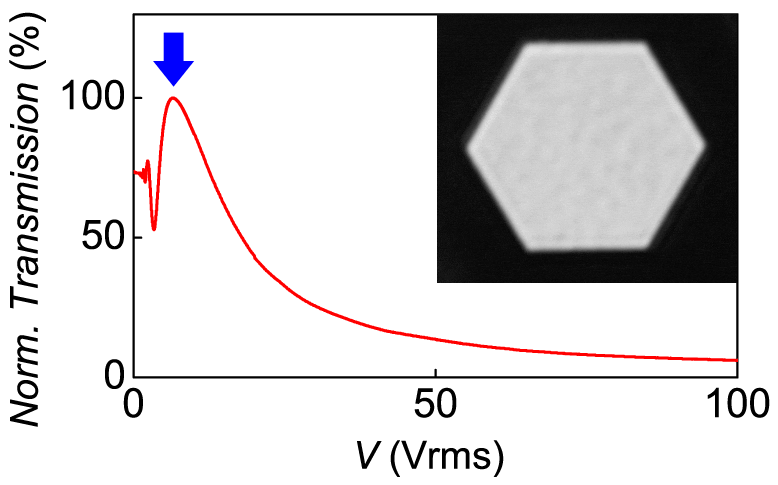| Posted: Apr 24, 2008 | |
LCDs might be graphene's first realistic commercial application |
|
| (Nanowerk Spotlight) Following up on yesterday's Spotlight about graphene quantum dots, today we look at what might be the first realistic application of this revolutionary material. Back in December we reported on the development of transparent and conductive graphene-based composites for use as window electrodes in solid-state dye sensitized solar cells ("Ultrathin transparent graphene films as alternative to metal oxide electrodes"). While the researchers who conducted this work produced graphene by chemical oxidation of graphite, a multi-step process, new results from the University of Manchester group that discovered graphene in 2004 show a simpler route to producing graphene films that cannot only be used for solar cells but might be well suited for liquid crystal displays. | |
| "There are already several technologies that potentially allow mass production of thin graphene-based transparent conductors – besides the chemical exfoliation of graphite described in our most recent work, one can also think of epitaxial growth of graphene on top of a metal surface, followed by a transfer of such a layer onto a transparent substrate" Dr. Kostya Novoselov explains to Nanowerk. "These techniques are capable of producing continuous graphene films of thickness below five monolayers, which is required for realistic applications." | |
| Novoselov, The Royal Society Research Fellow, and a member of the Mesoscopic Physics Group at the University of Manchester, is one of the original team, led by Professor Andre Geim, that discovered graphene in 2004. In a recent article in Nano Letters ("Graphene-Based Liquid Crystal Device") the University of Manchester scientists, together with collaborators from the Institute for Microelectronics Technology in Chernogolovka, Russia, demonstrate the use of graphene as a transparent conductive coating for photonic devices and show that its high transparency and low resistivity make this two-dimensional crystal ideally suitable for electrodes in liquid crystal devices. | |
| "Graphene is only one atom thick, optically transparent, chemically inert, and an excellent conductor," says Novoselov. "These properties seem to make this material an excellent candidate for applications in various electro-optical devices that require conducting but transparent thin films. We believe graphene should improve the durability and simplify the technology of potential electronic devices that interact with light." | |
| Geim points out that transparent conducting films are an essential part of many gadgets including common LCD displays for computers, TVs and mobile phones. "The technology behind these devices uses thin metal-oxide films based on indium. But indium is becoming an increasingly expensive commodity and, moreover, its supply is expected to be exhausted within just 10 years. Forget about oil – our civilization is first to run out of indium. Scientists have this urgent task on their hands to find new types of conductive transparent films." | |
 |
|
| Liquid Crystal Device with electrodes made of graphene with different voltages applied. The overall width of the insert image is 30 microns. (Image: Mesoscopic Physics Group, University of Manchester) | |
| Although it is important to demonstrate the possibility and advantages of using graphene as a transparent conductive coating, the feasibility of its mass production is essential when considering realistic applications. Novoselov notes that no industrial technology can rely on the micromechanical cleavage technique that allows only minute quantities of graphene and, although sufficient for fundamental research and proof-of-concept devices, is unlikely to become commercially viable. | |
| "Recently, large-area conductive films have been demonstrated by using chemical exfoliation of graphite oxide and then reducing it to graphene" he says. "This could lead to a viable way of making thin graphene-based films, however, so far this technique has not demonstrated the ability to fully recover the excellent conductive properties of graphene. We propose an alternative approach. It involves making a graphene suspension by direct chemical exfoliation of graphite (rather than graphite oxide), which is subsequently used to obtain transparent conductive films on top of glass by spin- or spray-coating." | |
| The Manchester research team has now demonstrated highly-transparent and highly-conductive ultra-thin films that can be produced cheaply by this technique – basically "dissolving" graphite chunks into graphene and then spraying the suspension onto a glass surface. These resulting graphene-based films can be used in LCDs and, to prove the concept, the researchers demonstrate the first liquid crystal devices with graphene electrodes (see figure above). | |
| Novoselov believes that only a few small, incremental steps remain for this technology to reach mass production stage. "Graphene-based LCD products can appear in shops as soon as in a few years," he says. | |
 By
Michael
Berger
– Michael is author of three books by the Royal Society of Chemistry:
Nano-Society: Pushing the Boundaries of Technology,
Nanotechnology: The Future is Tiny, and
Nanoengineering: The Skills and Tools Making Technology Invisible
Copyright ©
Nanowerk LLC
By
Michael
Berger
– Michael is author of three books by the Royal Society of Chemistry:
Nano-Society: Pushing the Boundaries of Technology,
Nanotechnology: The Future is Tiny, and
Nanoengineering: The Skills and Tools Making Technology Invisible
Copyright ©
Nanowerk LLC
|
|
|
Become a Spotlight guest author! Join our large and growing group of guest contributors. Have you just published a scientific paper or have other exciting developments to share with the nanotechnology community? Here is how to publish on nanowerk.com. |
|
